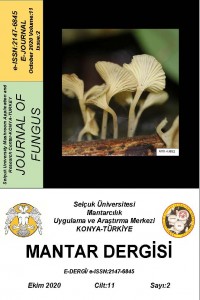Abstract
Bu çalışma, Edirne ilindeki 3 farklı caminin halı, halı tozu ve terliklerde mikrofungus tipleri ve sayılarının belirlenmesi, iç ortam halısında ve abdest alma esnasında kullanılan terliklerde dermatofit varlığının araştırılması amacıyla yapılmıştır. İstasyonlardan Ekim 2008 – Eylül 2009 tarihleri arasında alınan örneklerden, 12 ay süresince, toplam olarak 78937 KOB/g mikrofungus izole edilmiştir. Mikrofunguslardan 83 KOB/g’ı dermatofit fungustur. Terliklerde dermatofit tespit edilmemiştir. Halı örneklerinde 24 fungal cins tespit edilmiştir. Halıda tespit edilen mikrofunguslar arasında ilk sırayı 18533 koloni ve % 49,03 ile Penicillium cinsi almıştır. Bunu 13666 koloni ve % 25 ile Trichoderma cinsi, 9667 koloni ve % 12,34 ile Cladosporium cinsi üçüncü olarak takip etmiştir. Sadece bir camide bir kez (Temmuz 2009) Trichophyton rubrum bulunmuştur. Fungal cinslerin ve toplam mikrofungus konsantrasyonlarının çeşitli meteorolojik faktörlerle ilişkili olup olmadığını tespit etmek için istatistik analiz yapılmıştır. İç ortam halısındaki en yüksek değer 2. istasyonda Ekim ayında 6084 KOB/g izole edilmiştir. Sonuç olarak, üç camideki halı tozu fungus konsantrasyonlarının sağlıklı sınır değerleri arasında olduğu tespit edilmiştir.
Project Number
TUBAP-2009/64
References
- HALİDE AYDOĞDU Trakya University, Arda Vocational Collage, Edirne, Turkey halideaydogdu@trakya.edu.tr Trakya Üniversitesi Arda Meslek Yüksekokulu, Edirne.
- BEYZA ENER Uludağ University, Medical School, Department of Mirobiology and İnfectious Diseases, 16059 Bursa, Turkey. bener@uludag.edu.tr
Abstract
This study was conducted for the purpose of identifying the microfungi types and numbers in carpets, carpet dusts and slippers in three mosques in the Edirne City and surveying of microfungi during perform an ablution. It was isolated 78.937 CFU/g microfungi in total during 12 months from the samples taken between the dates of October 2008 and September 2009 from the stations. Of the microfungi 83 CFU/g were dermatophyte. It was identified only one dermatophyte in the slippers. It was identified 24 fungal species in carpet samples. The genus Penicilium was on the first rank with 18.553 CFU/g and 49.03 % in carpets, followed by Trichoderma with 13.666 CFU/g and 25 %, and followed Cladosporium ranked three with 96.666 CFU/g and 12.34 %. It was found the dermatophyte Trichophyton rubrum in the mosques only for once (July 2009). Statistical analysis for identifying whether the fungal types and the total microfungi concentrations are related with various meteorological factors. The highest value in indoor carpets was isolated as 6.084 CFU/g on the October. As a result, it was identified that the carpet dust fungus concentrations in three mosques are within the range of healthy limit values.
Supporting Institution
Trakya Universtiy Scientific Research
Project Number
TUBAP-2009/64
References
- HALİDE AYDOĞDU Trakya University, Arda Vocational Collage, Edirne, Turkey halideaydogdu@trakya.edu.tr Trakya Üniversitesi Arda Meslek Yüksekokulu, Edirne.
- BEYZA ENER Uludağ University, Medical School, Department of Mirobiology and İnfectious Diseases, 16059 Bursa, Turkey. bener@uludag.edu.tr
Details
| Primary Language | English |
|---|---|
| Journal Section | RESEARCH ARTICLE |
| Authors | |
| Project Number | TUBAP-2009/64 |
| Publication Date | October 28, 2020 |
| Published in Issue | Year 2020 Volume: 11 Issue: 2 |
The works submitted to our journals are first judged grammatically. After this phase, articles are sent two reviewers. If necessary, the third reviewer is assessed. In the publication of works, a decision is made by evaluating the level of contribution to science and readers within the criteria specified in the writing rules. Reviewers are requested to submit their assessments within 30 days at the latest. The reviewers' evaluations and the answers to these evaluations are reviewed by the editor and it is decided whether the work will be published or not.
International Peer Reviewed Journal
The journal doesn’t have APC or any submission charges

This work is licensed under a Creative Commons Attribution 4.0 License


